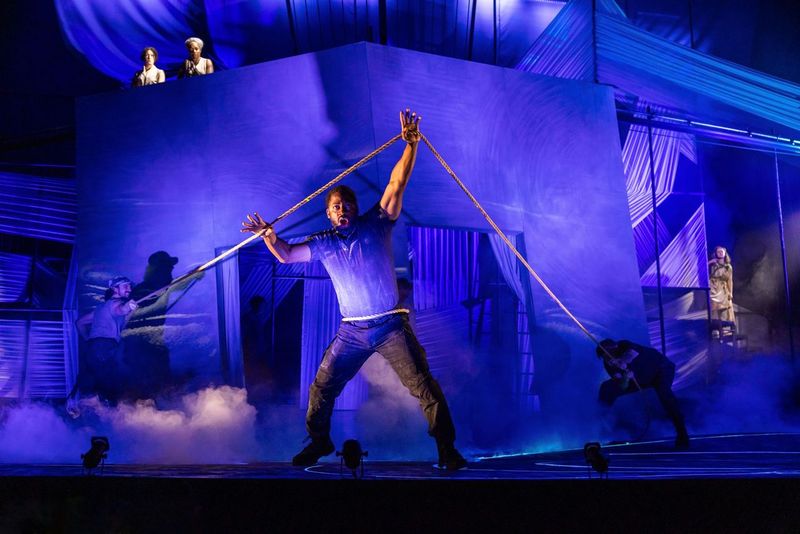
Photo Credits: Nile Scott Studios and Maggie Hall.
‘The Odyssey’ – Written by Kate Hamill. Based on the epic poem by Homer. Scenic Design by Sibyl Wickersheimer; Costume Design by An-Lin Dauber; Lighting Design and Projection Design by Jeanette Oi-Suk Yew; Sound Design and Music Composition by Paul James Prendergast. Presented by American Repertory Theater at Loeb Drama Center, 64 Brattle St., Cambridge, MA, through March 16.
By Shelley A. Sackett
“If you’ve gone through something traumatic, can you ever go back to who you were? Can you ever go back home?” is the essential question American Repertory Theater’s Terrie and Bradley Bloom Artistic Director Diane Paulus asks audience members to consider as they experience the world premiere of Kate Hamill’s A.R.T.-commissioned newest work, ‘The Odyssey.’ This spectacularly produced reimagination of Homer’s 8th/7th century B.C. epic poem is the latest retelling of a classic tale by Hamill, who, once again, displays her special talent for penning plays that magically remain true to the original while interweaving parallel contemporary issues, culture and language.
Hamill’s version of The Odyssey evokes both memories of ninth-grade English class and the latest headlines. She is a true master storyteller and alchemist. For three hours (two welcomed intermissions), the audience rides shotgun as she personalizes and contextualizes the Greek epic that follows the hero and king of Ithaca, Odysseus, and his homecoming journey after the ten-year-long Trojan War. During the decades-long trip from Troy to Ithaca, he encounters many perils, and all of his crewmates are killed. During Odysseus’ inexplicably long absence (the distance from Troy to Ithaca is only 565 nautical miles), he is presumed dead, leaving his wife Penelope and son Telemachus to contend with a group of unruly suitors competing for Penelope’s hand in marriage.
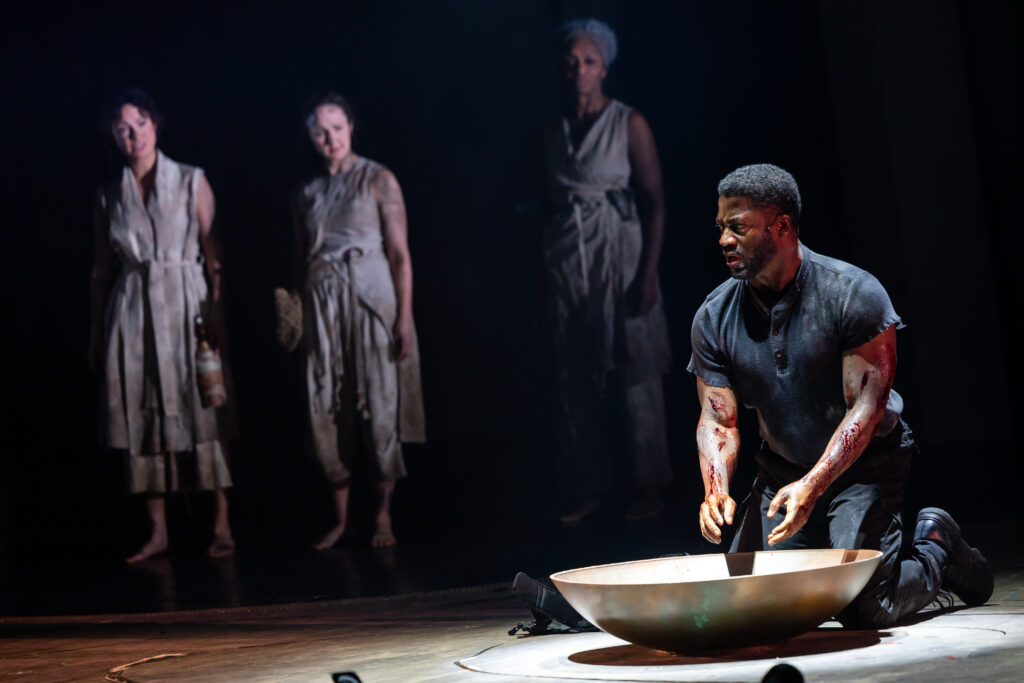
Homer’s original tale stresses ethical ambiguity and codes of heroic values and displacement. Hamill breathes contemporary life into these themes, adding her own twists that highlight the trauma of war on both those who fight and those they leave at home. Her trademark feminist lens focuses tightly on the play’s many female characters, especially Penelope and her struggles during Odysseus’ 20-year absence.
Sibyl Wickersheimer’s set is magnificent in elegance, simplicity and flexibility. Hundreds of yards of fabric shroud the stage as tasseled drapes hanging from the ceiling, geometric sculptural patterns along the back wall, and flowing, free panels. Shifting lighting and projections (Jeanette Oi-Suk Yew) change their color, mood and function. Cut-out boards and shapes shift function from ship to palace to island. The effect is dreamlike and captivating.
Act I opens on a beach with a chorus of three masked women who approach Odysseus (a credible Wayne T. Carr), as he scrubs his hands in a bowl of water. They act as narrators, dramatically bringing the audience up to speed on Odysseus’ life as king, husband, father and, above all, soldier. They are his guides and will accompany him throughout his travels.
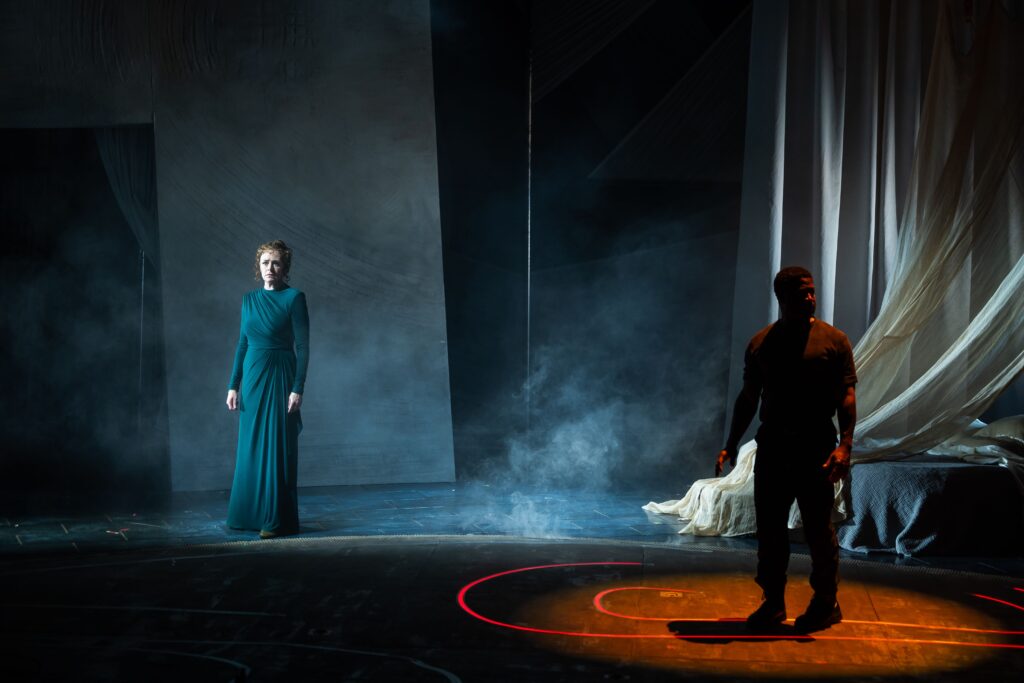
We learn that Odysseus is the only man who has not yet returned to Ithaca from the war in Troy. Shadow puppets (which appear throughout the play in various forms) illustrate his tale. The effect is Shakespearean, the triad reminiscent of the three witches, and Odysseus’ frantic hand-scrubbing is a hat tip to Lady Macbeth’s obsessive hand-washing in her effort to rid herself of feelings of shame and guilt.
“Your hands are clean,” the women croon, but Odysseus only revs up the pace in response.
In a flash, the language shifts from classical to contemporary vernacular and the beached ship morphs into a disco-like scene, complete with music, sexual innuendos and lots of swearing. We are in Ithaca, where Queen Penelope’s home has been besieged by rough-neck “suitors” intent on becoming the next king.
Flash again, and we are back with Odysseus, docked on an island inhabited by Titans. He and his men encounter the Cyclops, Polyphemus, when they search for food in a cave. Clever staging simultaneously evokes the giant and the cave through projections, puppetry and shadows. The three women (who also play different supporting characters in each scene) are charming as the mouth-watering lambs the men follow into the cave.
Act II is devoted to the cunning sea-witch goddess, Circe (played with impeccable timing, intonation and physicality by a scene-stealing Kate Hamill), and her island Aeaea, where Odysseus and his men almost meet their match. Circe agrees to let the men live if Odysseus stays with her. Finally, he snaps out of his drugged state of no man’s land when one of his men reminds him that, painful as it might be, he needs to confront himself, deal with his sins and pain, and return to his family.
“You can’t forget everything, or you forget what’s worth living for. Don’t you want to go home?” he is asked.
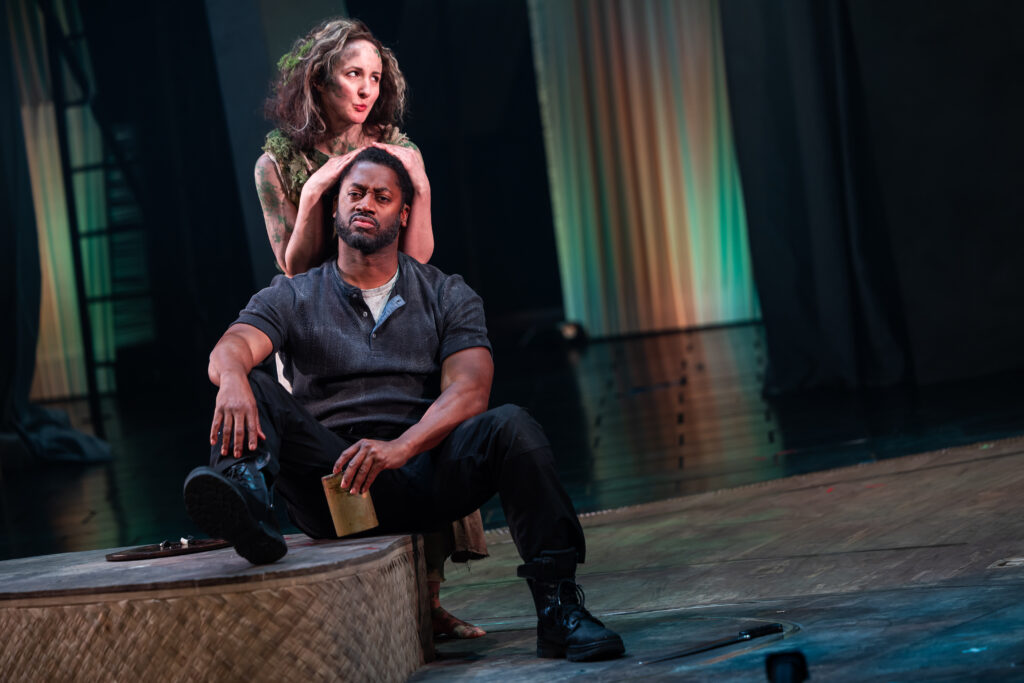
Meanwhile, back in Ithaca, Penelope’s (lithe and elegant Andrus Nichols) outer resolve begins to falter as Amphinomus (Keshav Moodliar) begins to chip away at it with seductive, honey-tongued persistence. The deliciously hung fabric is an exquisite setting in pastel hues of mauve and pink. Penelope admits she is tired of being afraid and alone. “I am worn out by memories,” she says. “I’m not free to choose, but I can touch.”
Act III is the longest and most lively, as Odysseus makes his way home (after a couple more stops) and eventually wins back his throne and family. There are bloody battles, disco galore and plenty of irreverent language. The play may be long, but the pace and production values keep it rolling and engaging.
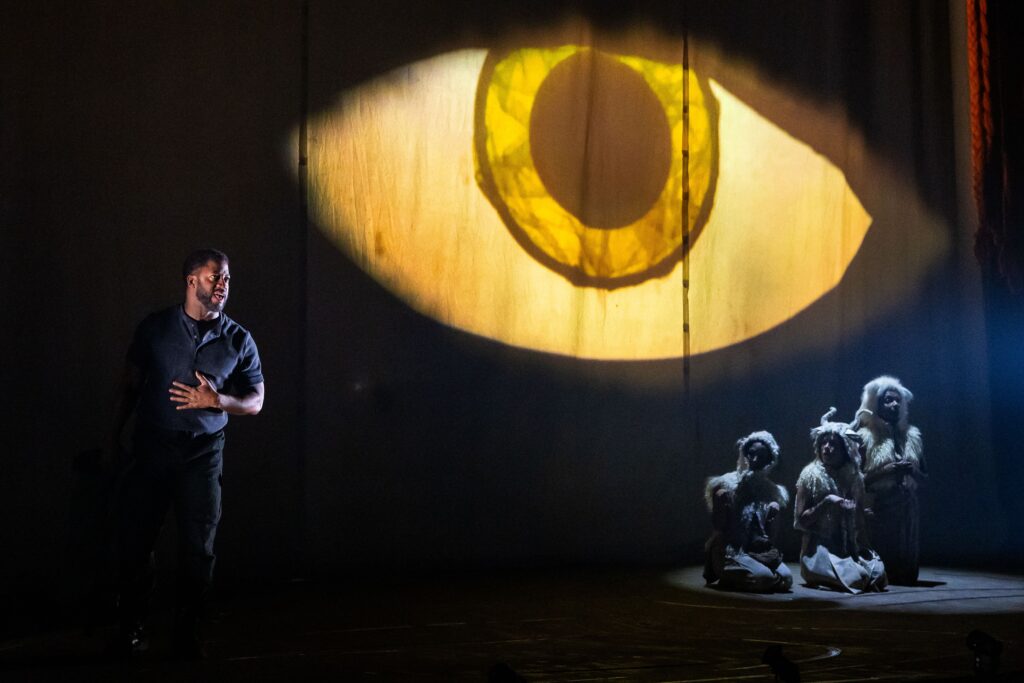
Director Shana Cooper has an excellent ensemble assembled, and her pacing, transitions and seamless blocking are all spot-on. Hamill’s script, as always, is a mashup of the classic and contemporary, fiercely loyal to the underlying ancient tale, yet spinning an exciting, smart and thought-provoking contemporary cocoon around it. The result is an adaptation that is accessible to all and explores big-ticket concepts.
What are the relationships between trauma, memory and violence, for example? Who are our heroes and what are their values? In this era of migration and displacement physically, emotionally and politically, what does “home” mean and how secure is it?
Hamill’s works are always something to look forward to. The curtain call at ‘The Odyssey’ left me eager to see what she will tackle next.
For more information and to buy tickets, go to https://americanrepertorytheater.org/

